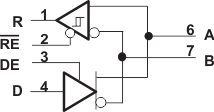ZHCSAC4B October 2012 – November 2017 SN65HVD82
PRODUCTION DATA.
1 特性
- 总线 I/O 保护
- 工业温度范围:-40°C 至 85°C
- 用于噪声抑制的较大接收器滞后(典型值为 60mV)
- 低功耗
- <1µA 待机电流
- <1mA 静态电流
- 信号传输速率经优化高达 250kbps
- 借助 WEBENCH® 电源设计器,使用 SN65HVD82 创建定制设计方案
2 应用
- 电表
- 楼宇自动化
- 工业网络
- 安全电子器件
3 说明
该器件兼具驱动器和接收器功能,稳健耐用,可满足特定工业 应用中的严格要求。这些总线引脚可耐受 ESD 事件,并且具备符合人体模型、气隙放电和接触放电规范的高水平保护。
该器件将差分驱动器与差分接收器相结合,共同由单个 5V 电源供电。驱动器差分输出和接收器差分输入在内部连接,构成一个适用于半双工(两线制总线)通信的总线端口。该器件 具有 宽共模电压范围,因此适用于长线缆上的 多点 应用。该器件的额定温度范围介于 -40°C 和 85°C 之间。
器件信息(1)
| 器件型号 | 封装 | 封装尺寸(标称值) |
|---|---|---|
| SN65HVD82 | SOIC (8) | 4.90mm x 3.91mm |
- 如需了解所有可用封装,请参阅数据表末尾的可订购产品附录。
逻辑图(正逻辑)
